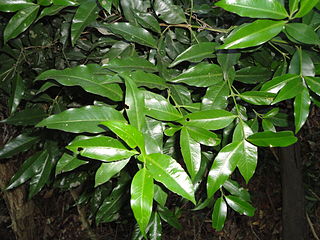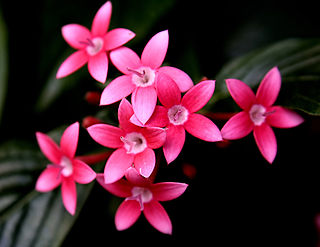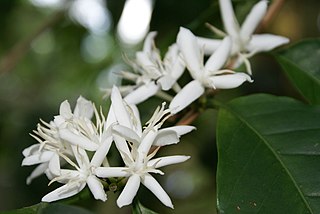
The Rubiaceae are a family of flowering plants, commonly known as the coffee, madder, or bedstraw family. It consists of terrestrial trees, shrubs, lianas, or herbs that are recognizable by simple, opposite leaves with interpetiolar stipules and sympetalous actinomorphic flowers. The family contains about 13,500 species in about 620 genera, which makes it the fourth-largest angiosperm family. Rubiaceae has a cosmopolitan distribution; however, the largest species diversity is concentrated in the tropics and subtropics. Economically important genera include Coffea, the source of coffee, Cinchona, the source of the antimalarial alkaloid quinine, ornamental cultivars, and historically some dye plants.

Bertiera is a genus of flowering plants in the family Rubiaceae. It comprises 57 species with most known from tropical Africa, five known from various Indian Ocean islands and five found in the tropics of the Americas.
Calycosiphonia is a genus of flowering plants in the family Rubiaceae. It is native to tropical Africa from Ivory Coast to Sudan to Mozambique.
Hymenocoleus is a genus of flowering plants in the family Rubiaceae and occurs in tropical Africa.

Leptactina is a genus of flowering plants in the family Rubiaceae. There are about 27 species. They are all native to sub-Saharan Africa, where most occur in rainforest habitat.

Rothmannia is a genus of flowering plants in the family Rubiaceae. It was described in 1776 and is named for Göran Rothman (1739–1778) by Thunberg – both were pupils of Linnaeus.

Tricalysia is a genus of flowering plants in the family Rubiaceae. The genus is found in tropical and southern Africa and on the islands in the Western Indian Ocean.

Vangueria is a genus of flowering plants in the family Rubiaceae. The genus is named for Voa vanguer, as V. madagascariensis is known in Malagasy.

Vanguerieae is a tribe of flowering plants in the family Rubiaceae and contains about 655 species in 30 genera. It is one of the most species-rich groups within the family and it is distributed across the Paleotropics.
Cuviera is a genus of flowering plants in the family Rubiaceae native to tropical Africa. It was originally described by Augustin Pyramus de Candolle in 1807 and is named after the French naturalist Georges Cuvier.
Argocoffeopsis is a genus of flowering plants in the family Rubiaceae. It is found in tropical Africa. They are lianas, climbing by means of horizontal or recurved lateral branches, or sometimes shrubs. Their papery bark is grey or brown and peeling off.
Globulostylis is a genus of flowering plants in the family Rubiaceae. It comprises 8 species growing in Central Africa.
Virectaria is a genus of flowering plants in the family Rubiaceae. The genus, known as Virecta until 1952, consists exclusively of tropical African species. It is a Guineo-Congolian genus, having its highest diversity in Lower Guinea but it also occurs in the Zambezian Region. Verdcourt provided a revision in which he defined five species but three more were added later. In 2001, a detailed morphological and anatomical study of the genus was conducted and a taxonomic survey and a key to the species was provided.

Empogona is a genus of flowering plants in the family Rubiaceae. The genus is found in tropical and southern Africa and Madagascar. It was for a time deemed a subgenus or section of Tricalysia.

Knoxieae is a tribe of flowering plants in the family Rubiaceae and contains about 131 species in 16 genera. Its representatives are found in Tropical and Southern Africa, the islands in the Western Indian Ocean, the Arabian Peninsula, Tropical and Subtropical Asia, and Northern Australia.

Coffeeae is a tribe of flowering plants in the family Rubiaceae and contains about 333 species in 11 genera. Its representatives are found in tropical and southern Africa, Madagascar, the western Indian Ocean, tropical and subtropical Asia, and Queensland.

Sabiceeae is a tribe of flowering plants in the family Rubiaceae and contains about 164 species in 7 genera. Its representatives are found in tropical Africa, Madagascar, Sri Lanka, and from Mexico to tropical America. The genus Sabicea is one of the rare genera in Rubiaceae that occurs both in tropical Africa and tropical America.
Palicoureeae is a tribe of flowering plants in the family Rubiaceae and contains about 817 species in 11 genera. Its representatives are found in the tropics and subtropics.
Kupeantha is a genus of flowering plants in the family Rubiaceae. It is found in Cameroon and Equatorial Guinea. The genus is closely related to Argocoffeopsis and Calycosiphonia.










